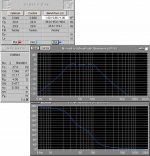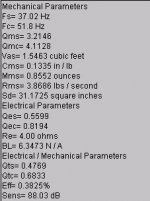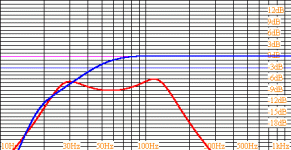I designed this subwoofer, its using 2 8" drivers,
and i wanted to know if the response curves are ok, and if i should do something to make it better, or if its ok
and i wanted to know if the response curves are ok, and if i should do something to make it better, or if its ok
What is the rated SPL @ 1W/1M of your speakers?
The curve of your subwoofer--3 dB at 25 Hz, using two 8 inch speakers, (equivalent of one 12 inch), is very, very good, if the SPL of the rated speakers is 88 dB @ 1W/1M or above. If it is much under that, then there is a dropoff in performance.
The curve of your subwoofer--3 dB at 25 Hz, using two 8 inch speakers, (equivalent of one 12 inch), is very, very good, if the SPL of the rated speakers is 88 dB @ 1W/1M or above. If it is much under that, then there is a dropoff in performance.
Thanks for the reply
how can i find the rated SPL @ 1W/1m? i bought those driver preety oem, and thats why they were cheap but i think they are awsome, and i calculated the specs needed for the box design.
I've being working on it, to reduce the volume because it was too big
thats the new version.
what do u think of it?
btw, its all in imperial system
how can i find the rated SPL @ 1W/1m? i bought those driver preety oem, and thats why they were cheap but i think they are awsome, and i calculated the specs needed for the box design.
I've being working on it, to reduce the volume because it was too big
thats the new version.
what do u think of it?
btw, its all in imperial system
Attachments
Drivers are OK
So its sensitivity is 88.03dB as shown by that chart. Now just make sure you use at least a 3" flared port to aviod port noises from trying to pass too much air. Flared ports can move air faster, so a 3" non-flared port might make chuffing sounds, but a 3" flared port probably won't.
So its sensitivity is 88.03dB as shown by that chart. Now just make sure you use at least a 3" flared port to aviod port noises from trying to pass too much air. Flared ports can move air faster, so a 3" non-flared port might make chuffing sounds, but a 3" flared port probably won't.
your software looks like a newer version of one I have...
I also had the problem with the imperial unit thing. Converting N/mm to Lb/in or whater it is is crazy even with my old TI-85. Try clicking on the Lb/in, it should cycle through and eventually get to N/mm. After you go throughabout 6 different conversions. This also works for all the measurements.
I also had the problem with the imperial unit thing. Converting N/mm to Lb/in or whater it is is crazy even with my old TI-85. Try clicking on the Lb/in, it should cycle through and eventually get to N/mm. After you go throughabout 6 different conversions. This also works for all the measurements.
A) Your amplitude response at 2.83 input is only about 79 dB. Very very low.
B) The sensitivity of the speakers is given as 88 dB-about normal. However, these are actually 5 or 6 ohm speakers-that sensitivity rating might be inflated.
Sensitivity is sometimes measured by watt, often by 2.83 volts at 1 Meter. 2.83 volts produces one watt in 8 ohm speaker. However, it produces 2 watts in a 4 ohm speaker. A 6 ohm speaker measured this way will be overrated by 1.5 dB-which isn't so outrageous, actually.
Hang on, let me check with this parameter calculator. I thinkyou can do better than that design.
B) The sensitivity of the speakers is given as 88 dB-about normal. However, these are actually 5 or 6 ohm speakers-that sensitivity rating might be inflated.
Sensitivity is sometimes measured by watt, often by 2.83 volts at 1 Meter. 2.83 volts produces one watt in 8 ohm speaker. However, it produces 2 watts in a 4 ohm speaker. A 6 ohm speaker measured this way will be overrated by 1.5 dB-which isn't so outrageous, actually.
Hang on, let me check with this parameter calculator. I thinkyou can do better than that design.
I think a best shot is your ported box. If you take a look at the midpoint of your bandpass, you see that it's throughout most of it's range, it's playing at 75 dB or so at 2.83 input.
The sensitivity of the woofers is either 88 or 86.5 dB. The bandpass is lowering their output-smoother line, but lowering the output throughout it's playing range.
The following graph WinISD graph contains two speaker responses.
The one in red is for a bandpass enclosure with characteristics very similar, though not identical, to yours.
The line in blue represents the two woofers in a bass reflex cabinet, 2.6 cu. ft., tuned to 25 Hz.
As you can see, the two curves meet around 25 Hz. However, the ported system is much more sensitive throughout most of the playing range.
The sensitivity of the woofers is either 88 or 86.5 dB. The bandpass is lowering their output-smoother line, but lowering the output throughout it's playing range.
The following graph WinISD graph contains two speaker responses.
The one in red is for a bandpass enclosure with characteristics very similar, though not identical, to yours.
The line in blue represents the two woofers in a bass reflex cabinet, 2.6 cu. ft., tuned to 25 Hz.
As you can see, the two curves meet around 25 Hz. However, the ported system is much more sensitive throughout most of the playing range.
Attachments
Two more things to consider.
When put near a corner, the output of the port frequency is increased up to 6 dB. It gets less the farther from the corner you go. The ported box's port frequency is 25 Hz-right where you can use a boost. The bandpass box's port frequency is 55 Hz or so-where you don't need help.
In a ported box, the cone is moving ony about one fourth as much as it would in a closed box to produce the same bass. There is probably very little help from the port at 25 or 30 Hz in your bandpass. that means that your cone is moving three or four times as much to produce the same bass output.
When a big bass note comes at 25 Hz or so, you are very likely to run out of excursion with the bandpass. Not with the ported. the port aids the reflex box right where it needs it the most.
Try a reflex box, 2.6 cubic feet, 25 Hz tuning, and see what you get. Oh, yes, the bass distortion will be much less with the reflex box as well.
Just a suggestion.
When put near a corner, the output of the port frequency is increased up to 6 dB. It gets less the farther from the corner you go. The ported box's port frequency is 25 Hz-right where you can use a boost. The bandpass box's port frequency is 55 Hz or so-where you don't need help.
In a ported box, the cone is moving ony about one fourth as much as it would in a closed box to produce the same bass. There is probably very little help from the port at 25 or 30 Hz in your bandpass. that means that your cone is moving three or four times as much to produce the same bass output.
When a big bass note comes at 25 Hz or so, you are very likely to run out of excursion with the bandpass. Not with the ported. the port aids the reflex box right where it needs it the most.
Try a reflex box, 2.6 cubic feet, 25 Hz tuning, and see what you get. Oh, yes, the bass distortion will be much less with the reflex box as well.
Just a suggestion.
Member
Joined 2002
I built a band pass sub
I build a band pass sub for my room for my computer useing a kicker c10" sub And man it was loud put about 40 watts into it and it was majorly loud. i was impressed.
I build a band pass sub for my room for my computer useing a kicker c10" sub And man it was loud put about 40 watts into it and it was majorly loud. i was impressed.
Jason:
Bandpass subs can be very good. They can raise output per watt or lower it, depending on how they are built.
The bandpass sub here has a lot of bass extension, but as you can see, it plays at 79 dB @ 2.83 volts throughout most of it's range.
I certainly do not have anything against bandpass subs as a whole. I just thought that much can be gained by compaing this bandpass to a ported sub.
Bandpass subs can be very good. They can raise output per watt or lower it, depending on how they are built.
The bandpass sub here has a lot of bass extension, but as you can see, it plays at 79 dB @ 2.83 volts throughout most of it's range.
I certainly do not have anything against bandpass subs as a whole. I just thought that much can be gained by compaing this bandpass to a ported sub.
Member
Joined 2002
yes i agree there awsome for stereo's that dont have alot of output and ect ect but there box sie is larger..
the system is efficiant witch is what i like..
J'
the system is efficiant witch is what i like..
J'
thanks for all the replies
one of my major concerns in all this is size...
2.6 cu.f is enormous.
the bandpass i did was 1.7 cu.f and it was a bit too big,
after seeing kelticwizard 's graphs, i see vented would be way better than my design. Any ideas on how to reduce the vented woofer size while keeping the same bass?
i wonder how they do it on this klipsch woofer on the promedia systems.
http://www.klipsch.com/images/productmedia/large/76_large.jpg
its a dual 8" vented.
one of my major concerns in all this is size...
2.6 cu.f is enormous.
the bandpass i did was 1.7 cu.f and it was a bit too big,
after seeing kelticwizard 's graphs, i see vented would be way better than my design. Any ideas on how to reduce the vented woofer size while keeping the same bass?
i wonder how they do it on this klipsch woofer on the promedia systems.
http://www.klipsch.com/images/productmedia/large/76_large.jpg
its a dual 8" vented.
Well, one way to keep the same bass curve while cutting down on box size is to use just one woofer. A 1.3 cu ft box will give the same bass curve as 2 woofers in a 2.6 cu ft box.
Isobaric is also supposed cut box size in half, though I often wonder if the arrangements of the woofers don't use most of that advantage up. Anyway, I have never built one. If nobody comes up with some advice about isobaric in this thread, you might consider starting another thread about an isobaric design for your sub. I can't help you much there.
Isobaric is also supposed cut box size in half, though I often wonder if the arrangements of the woofers don't use most of that advantage up. Anyway, I have never built one. If nobody comes up with some advice about isobaric in this thread, you might consider starting another thread about an isobaric design for your sub. I can't help you much there.
i've built 3 subs ín this design. The only real dissapointment in the design is that the respons is a little slower than both closed/vented designs. However 4th order can be highly impressive. The pushpull version will lower the units vas to ½ of what stated in the specs/measured.
Kind regards Per.
Kind regards Per.
thanks for the reply per.
how does the pushpull work to reduce the size?
when i simulate a push pull 4th order bandpass, i get the same results as in a standart driver config...
how does the pushpull work to reduce the size?
when i simulate a push pull 4th order bandpass, i get the same results as in a standart driver config...
Look for another driver
My thought about isobaric is that instead of wasting the 6dB increased output of one perfectly ok driver one should go looking for another driver. Have a look at the maximim SPL output (WinISD Pro) and enclosures with such a low F3 and a small woofer obviously make little sense.
Isobaric enclosures follow the iron law. You have 3dB less sensitivity but 3dB more power handling getting you to the same place with twice the power and half the internal space. However ports can be a problem to fit in such configurations as the box size gets small.
Just my 2c
My thought about isobaric is that instead of wasting the 6dB increased output of one perfectly ok driver one should go looking for another driver. Have a look at the maximim SPL output (WinISD Pro) and enclosures with such a low F3 and a small woofer obviously make little sense.
Isobaric enclosures follow the iron law. You have 3dB less sensitivity but 3dB more power handling getting you to the same place with twice the power and half the internal space. However ports can be a problem to fit in such configurations as the box size gets small.
Just my 2c
- Status
- Not open for further replies.
- Home
- Loudspeakers
- Subwoofers
- 4th order Subwoofer



